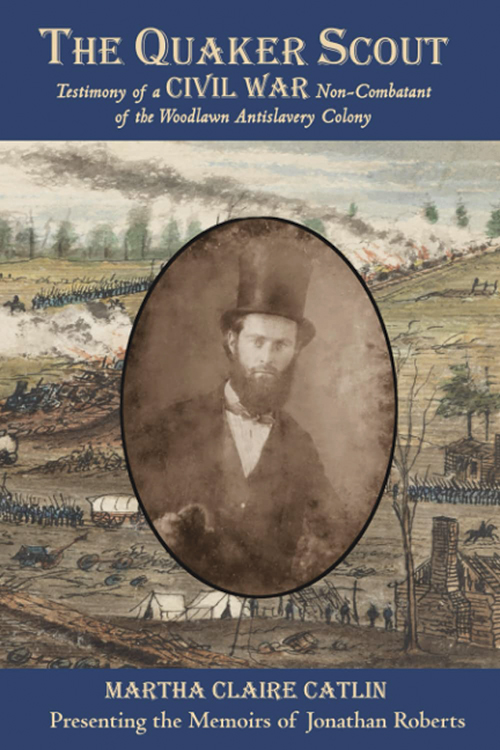
The Quaker Scout: Testimony of a Civil War Non-Combatant of the Woodlawn Antislavery Colony
Reviewed by Larry Ingle
January 1, 2023
By Jonathan Roberts, presented by Martha Claire Catlin. Quaker Heron Press, 2022. 320 pages. $19.99/paperback.
First published in 1891 in a newspaper, this memoir of Jonathan Roberts (born in 1818 into a Quaker family in Chester Township, N.J.) is a valuable addition to the literature of Friends in the pre-Civil War period. What makes it so important is its demonstration of how some antebellum Friends were involved in antislavery activity far beyond participation in the Underground Railroad. Their radical dream of a free-labor farm in the South where they could entice slaveholders to give up their human property and use modern agricultural practices drove them forward. The record of their effort is now available for all to peruse.
Roberts and a group of Hicksite Friends moved to northern Virginia and established the Woodlawn Antislavery Colony that was free-soil (used to describe territory where prior to the Civil War slavery was prohibited) and open to free African Americans. An idea first hatched by Virginia Friend Samuel M. Janney, such a farm would prove that they could salvage land that had undergone exhaustive one-crop farming and that it would be profitable without the use of enslaved labor. In the mid-1840s, they purchased land adjacent to George Washington’s Mount Vernon plantation, and the colony started to grow. In 1849, they established the Woodlawn Indulged Meeting (similar to a preparative meeting today) under Alexandria (Va.) Meeting. Roberts considered himself “always an outspoken anti-slavery man” yet was able to retain good relations with his White Southern neighbors.
When the Civil War began in 1861, he became a scout and informant for Union forces, a job that made him a target for Confederate rebels, but his reputation as an upright, property-holding Friend helped shield him and allowed him to survive until the twentieth century: 1901. Editor Martha Claire Catlin stretches a bit to suggest that his scouting for the U.S. Army made him an early noncombatant conscientious objector. His successful farming and integration into his local northern Virginia community left a more memorable historical legacy.
The colonists began with about 2,900 acres, a figure doubled by 1850, as they sold tracts to Friends, other northerners, and the few Black farmers who could afford to purchase them. Land values soared: in 1846 Woodlawn’s property was worth $12.50 an acre; 15 years later, the same acre stood at $100. The colony had a Quaker meetinghouse and, after the war, churches for Black residents and their families.
Catlin is a talented amateur historian—may their tribe increase!—but she has made her too-numerous endnotes tell readers more than most would need or want to know, but those can always be skipped. What she has done is rescue and offer a memoir that expands our knowledge of what Friends did on their own to oppose slavery, and she has provided another definition of the possibilities of what a free society could produce. We scholars and interested readers are much in her debt.
Currently co-clerk of Chattanooga (Tenn.) Meeting with his wife, Becky, Larry Ingle is a historian of Quakerism. His most recent book is Nixon’s First Cover-Up: The Religious Life of a Quaker President (2015). He is professor emeritus of history at the University of Tennessee at Chattanooga.



Comments on Friendsjournal.org may be used in the Forum of the print magazine and may be edited for length and clarity.